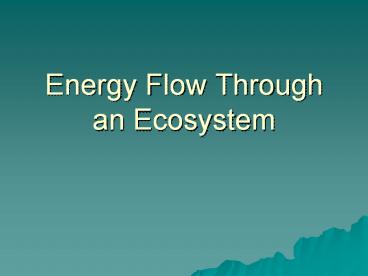Energy Flow Through an Ecosystem Levels of Ecological PowerPoint PPT Presentation
1 / 17
Title: Energy Flow Through an Ecosystem Levels of Ecological
1
Energy Flow Through an Ecosystem
2
- Levels of Ecological Organization
- Energy flows through these levels
3
Levels of Organization
- Species similar organisms that can produce
fertile offspring.
- Populations individuals that are of the same
species and live together
4
- Communities Different populations that live
together in an area - Ecosystems All the biotic and abiotic factors
of an area.
Give an example of a population, community and
ecosystem at ETHS
5
Energy Flow Through an Ecosystem
- Thermodynamics the study of energy
transformations - Law 1 Energy can be transferred and changed but
it CANNOT be created nor destroyed. - Energy only flows through an ecosystem in one
direction, from the sun or inorganic compounds to
autotrophs (producers) and then to various
heterotrophs (consumers) - Sunlight is the main energy source for life on
Earth - Inorganic compounds (minerals) can also be energy
sources (deep ocean)
6
- Trophic Level classification of an organism
based on their source of energy - Energy flows through the different levels of an
ecosystem
7
1st Trophic Level-- Producers
- Can harness energy directly from their physical
environment (sun) - Transform this energy into chemical energy
- used as food, combine or break down molecules,
make cells - Called autotrophs because they can make their own
food - Examples plants, bacteria and some algae
8
2nd Trophic Level -- Consumers
- Organisms that rely on other organisms for
chemical energy - Cannot harness energy directly from their
physical environment - Called heterotrophs because they cannot make
their own food - Examples animals, fungi, many bacteria
- Q Do all consumers eat the same thing?
9
Herbivores
- Energy source comes from eating only producers
- Also called primary consumers
- Examples cows, caterpillars, ducks, deer
10
3rd Trophic Level-- secondary consumers
- Organisms whose energy source comes from other
consumers - Divided into two groups
- Omnivores
- Carnivores
11
- Omnivores
- Eat both consumers and producers
- Examples bears, crows, humans
- Carnivores
- Only eat other consumers
- Considered meat eaters
- Examples tigers, snakes, owls, dogs
12
4th Trophic Level -- Top Carnivores
- Carnivores that consume other carnivores
- Example a hawk that eats a snake
13
Detritivores and Decomposers
- Consumers whose energy source comes from waste
and dead bodies from organisms of all trophic
levels - Cause decay or the break down of molecules
- Examples scavengers, bacteria, fungi
- Q Why are detritivores and decomposers useful?
14
- Food Chain Shows only one path of energy flow
- Food Web Shows multiple paths of energy flow
15
- Q What happens to the energy?
- Some is stored in the body used later for things
like growth - Some is lost in waste
- what the body cant digest or already has enough
of - Most leaves as heat
- Only about 10 of available energy is actually
transferred from one trophic level to the next - as you go up in trophic levels, the amount of
useable energy goes down
16
Energy Pyramid
Energy is lost
One calorie the amount of energy needed to
raise the temp of 1g (1mL) water 1ºC
17
- Energy pyramids are NOT drawn based on the of
organisms at that level - Energy pyramids ARE drawn based on biomass and
amount of available energy at that level - Biomass total amount of living tissue, usually
referring to what can be used as fuel. - The producers level usually has the most biomass

